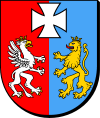Rzeszów
| Rzeszów | |||
|---|---|---|---|
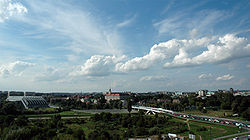 |
|||
|
|||
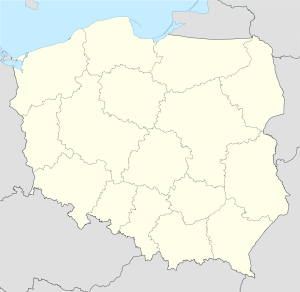 Rzeszów
|
|||
| Coordinates: | |||
| Country | |||
| Voivodeship | |||
| County | city county | ||
| Town rights | 1354 | ||
| Government | |||
| - Mayor | Tadeusz Ferenc | ||
| Area | |||
| - City | 116.4 km2 (44.9 sq mi) | ||
| Population (2010) | |||
| - City | 179,455 | ||
| - Density | 1,541.7/km2 (3,993/sq mi) | ||
| - Metro | 740,000 | ||
| Time zone | CET (UTC+1) | ||
| - Summer (DST) | CEST (UTC+2) | ||
| Postal code | 35-000 to 35-900 | ||
| Area code(s) | +48 17 | ||
| Car plates | RZ | ||
| Website | http://www.erzeszow.pl/ | ||
Rzeszów [ˈʐɛʂuf] (![]() listen) (Ukrainian: Ряшiв, Riashiv; Russian: Ряшев; Latin: Resovia; Yiddish: ריישע-rayshe) is a city in south-eastern Poland with a population of 172,813 (2009).[1] It is located on both sides of the Wisłok river, in the heartland of the Sandomierska Valley. The city, which was granted a town charter in 1354, has been the capital of the Subcarpathian Voivodeship since 1999, and is also the seat of the Rzeszów County.
listen) (Ukrainian: Ряшiв, Riashiv; Russian: Ряшев; Latin: Resovia; Yiddish: ריישע-rayshe) is a city in south-eastern Poland with a population of 172,813 (2009).[1] It is located on both sides of the Wisłok river, in the heartland of the Sandomierska Valley. The city, which was granted a town charter in 1354, has been the capital of the Subcarpathian Voivodeship since 1999, and is also the seat of the Rzeszów County.
Rzeszów is served by an international airport, is a member of Eurocities, and is home to a number of higher education schools, company headquarters, and foreign consulates.
Contents |
History
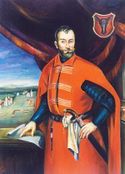
Rzeszów is located on an important trade route from Silesia and Lesser Poland (Małopolska) to Ruthenia.[2][3] This route was one which Atilla the Hun took on his way to conquer Asia in the 5th century and, according to legend, Atilla was buried in Przemyśl.[4] Rzeszów became a town in 1354, when the Polish king, Casimir III the Great, gave it city rights (Magdeburg rights).[3][5] At the time it was a remote Ruthenian settlement. At the beginning of the 15th century the town was destroyed by fire.[5] It grew rapidly in the 16th century when the local overlord Mikołaj Spytek Ligęza (c. 1562–1637) commissioned a church and fortified castle.[6][7] Subsequently ownership of Rzeszów passed to the Lubomirski, one of the most important noble families in Poland at the time.[8] Besides having a famous annual market, Rzeszów remained only another city on the trade route to Hungary. In 1658 Jerzy Sebastian Lubomirski established the Piarist school, the second secondary school in Poland. During the 19th century Rzeszów began to lose significance in favour of Przemyśl. Development of Rzeszów started when in 1937 military industry was located in the city: Państwowe Zakłady Lotnicze, producing aircraft engines, and a cannon factory– a branch of Hipolit Cegielski factory (see: Central Industrial Area).
20th Century
Until the outbreak of World War II the Jews of Rzeszów numbered 14,000, more than one-third of the total population.[9] The town was occupied by the German Army on 10 September 1939 and was renamed as "Reichshof".[9] German persecution of the Jews began almost immediately; by the end of 1939, there were 10 forced labour camps in the Rzeszów region and many Jews became slave labourers. Jews were forced to live in the Gestapo-controlled ghetto.[9] Many Jews managed to flee to Soviet occupied Poland. By June 1940, the number of Jews in Rzeszów had decreased to 11,800, of whom 7,800 were pre-war residents of the city; the rest were refugees from surrounding villages. Life in the ghetto was impossible and hundreds died. During the war some 20,000 Jews were murdered in the ghetto in Rzeszów. This number includes thousands who were sent to Rzeszów only to be deported or murdered soon after arrival. Of Rzeszóws 14,000 Jews, only 100 survived the war in Rzeszów itself, hiding all over Poland, and in various camps. After the war an additional 600 Rzeszów Jews returned from the Soviet Union. Almost all of them subsequently left the city and the country.
In 1991 Pope John Paul II visited Rzeszów. During the celebrations in which nearly 1,000,000 people participated, the pope beatified Bishop Józef Sebastian Pelczar, former bishop of Przemysl. On 25 March 1992 Pope John Paul II established the new Diocese of Rzeszów.[5] The city of Rzeszów became the administrative centre of the new Diocese and the Church of the Sacred Heart became the new city cathedral.[5] In 2004, Rzeszów hosted the Central European Olympiad in Informatics (CEOI).

Education
.svg.png)
Universities:
- Rzeszów University (established in 2001 from a number of smaller schools)[10]
- Rzeszów University of Technology (formed from The Higher Engineering School in 1974)
- University of Information Technology and Management (established in 1996) website
- Branches in Dębica, Krosno and Nisko
- Wyższa Szkoła Zarządzania website
- Wyższa Szkoła Administracji i Zarządzania in Przemyśl, branch in Rzeszów (established in 1995) website
Notable High Schools:
- Konarski's Number 1 High School in Rzeszów
Transport
Transit
Rzeszów is located on the main ![]() West-East European E40 Highway, which goes from Calais in France via Belgium, across Germany, Poland, Ukraine and onto Russia and Kazakhstan. (Within Poland the E40 follows the
West-East European E40 Highway, which goes from Calais in France via Belgium, across Germany, Poland, Ukraine and onto Russia and Kazakhstan. (Within Poland the E40 follows the ![]() A4 Highway and the DK 4 National Road). However, the
A4 Highway and the DK 4 National Road). However, the ![]()
![]() is not regarded as a ‘highway’ in the Rzeszów area — it is by Western standards, just a regular, one-lane main A-road. (although, it is currently being upgraded). Other Polish cities located by the E40 highway are Wrocław, Opole, Katowice, Kraków, Tarnów, Ropczyce and Przemyśl.
is not regarded as a ‘highway’ in the Rzeszów area — it is by Western standards, just a regular, one-lane main A-road. (although, it is currently being upgraded). Other Polish cities located by the E40 highway are Wrocław, Opole, Katowice, Kraków, Tarnów, Ropczyce and Przemyśl.
In recent years, communication has been improved by modernisation of the roads within the city. SCATS traffic system has been implemented.
Highway A4 is planned to be built as a beltway of the city, running through the northern districts of Rzeszów.
Airport
Rzeszów-Jasionka Airport (Port Lotniczy Rzeszów-Jasionka) is located in the village of Jasionka north of the city. Scheduled passenger services include flights to: Warsaw (WAW), Dublin, London (Stansted), Bristol, UK, Birmingham, UK, New York (JFK Airport, and Newark Liberty International Airport).
Buses
The city operates 49 bus lines including night and airport buses. Rzeszów is also a gateway to the Bieszczady mountains, with many buses heading for Sanok.[11]
Railways
Rzeszów is an important rail hub is on the main West-East rail route; Line 91. This runs from Silesia and Kraków, Kraków Main station (Kraków Główny) — Medyka on the Polish eastern border. This line then continues on to Ukraine. Its main railway station was established in the XIX century and apart from it, there are three additional stations in the city (Rzeszów Staroniwa, Rzeszów Zachodni and Rzeszów Zaleze). There are also two non-electrified lines stemming from Rzeszów - to Jasło and to Tarnobrzeg.
Culture
Theatres
- Theatre of Wanda Siemaszkowa (est. 1944)
- Theatre Maska
Museums
- Ethnographic Museum
- Museum of the City of Rzeszów
- Diocesan Museum
Other
- Philharmonic Hall of Artur Malawski
Economy
Industry
- Valeant Pharmaceuticals International (NYSE:VRX) Rzeszów (formerly ICN Polfa Rzeszów)
- United Technologies Corporation (NYSE:UTX) Pratt & Whitney division - Aerospace engineering including one of world's two F-16 engine manufacturers
- Zelmer SA - household equipment
- Asseco Poland SA (earlier Comp Rzeszów S.A) - computer software
- Novartis International AG (NYSE:NVS) Rzeszów - Gerber Products Company food production facilities
- Sanofi-Aventis (NYSE:SNY)
At Widelka substation, situated approximately 20 kilometres northnortheast of Rzeszów, the only 750 kV powerline in Poland, coming from Khelmitiskaja in Ukraine ends.
Main sights
- palace of Lubomirski family (18th century)
- main square
- town hall, established in 1591
- Small (17th century) and Big (18th century, restored 1954-63) Synagogue
- Łańcut palace
- Podziemia, underground tunnel.
Sports
- Resovia Rzeszów - the oldest men's football team in Poland (1905 or 1904) and men's volleyball team playing in Polish Volleyball League (Polska Liga Siatkówki, PLS: Seria B in 2003/2004, Seria A in 2004/2005 season).
- Stal Rzeszów - men's football team (Polish Cup winner 1975)
- Marma Rzeszów - motorcycle speedway Ekstraliga team
Notable people
As the largest city of the region Rzeszów has a diverse set of notable people associated with it. Hero of anti-Nazi and anti-Soviet resistance, Lukasz Cieplinski, singer Justyna Steczkowska, general Józef Zając, and leading theater director Jerzy Grotowski, among others, were born or lived in the city. Polish prime minister and commander-in-chief general Władysław Sikorski studied there, while pioneer of the oil industry, Ignacy Łukasiewicz, spent much of his life in Rzeszów.
Media
Radio
- Radio Rzeszów
- Radio Eska Rzeszów
- Akademickie Radio Centrum
- Katolickie Radio Via
- Radio RES
Press
- Gazeta Codzienna NOWINY
- Super Nowości
- Nasz Dom
Television
- Polish Television (TVP) branch in Rzeszów
- Rzeszów's cable television
- Local television Vectra (old DAMI)
- Municipal television Rzeszów
Climate
Rzeszów lies in the north temperate zone and has a continental climate with four distinct seasons. It is characterised by a significant variation between hot summers and cold, snowy winters. Average temperatures in summer range from 18 °C (64 °F) to 19.6 °C (67 °F) and in winter from −2.1 °C (28 °F) to 0 °C (32 °F). The average annual temperature is 8.9 °C (48 °F). In summer temperatures often exceed 25 °C (77 °F), and sometimes even 30 °C (86 °F), while winter drops to −5 °C (23 °F) at night and about 0 °C (32 °F) at day; during very cold nights the temperature drops to −15 °C (5 °F).[12][13] In view of the fact that Rzeszów lies near the Carpathian Mountains, there is sometimes a halny[14] – a föhn wind, when the temperature can rise rapidly.
| Climate data for Rzeszów | |||||||||||||
|---|---|---|---|---|---|---|---|---|---|---|---|---|---|
| Month | Jan | Feb | Mar | Apr | May | Jun | Jul | Aug | Sep | Oct | Nov | Dec | Year |
| Average high °C (°F) | 7 (45) |
8 (46) |
16 (61) |
22 (72) |
26 (79) |
29 (84) |
31 (88) |
30 (86) |
27 (81) |
22 (72) |
15 (59) |
10 (50) |
20.25 (68.45) |
| Average low °C (°F) | -19 (-2) |
-17 (1) |
-12 (10) |
-4 (25) |
0 (32) |
4 (39) |
7 (45) |
5 (41) |
1 (34) |
-4 (25) |
-9 (16) |
-15 (5) |
-5.25 (22.55) |
| Rainfall mm (inches) | 22.4 (0.882) |
23.1 (0.909) |
24.9 (0.98) |
39.7 (1.563) |
55 (2.17) |
59.5 (2.343) |
67.5 (2.657) |
51.9 (2.043) |
56.5 (2.224) |
33.3 (1.311) |
28.5 (1.122) |
24.9 (0.98) |
40.6 (1.598) |
| Source: EuroWeather and MSN Weather | |||||||||||||
International relations
Twin towns — Sister cities
Gallery
|
City hall |
 Theater of Wanda Siemaszkowa |
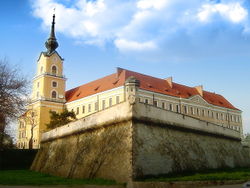 Palace of Lubomirski family |
Rzeszovian women's dress |
|
Historic market square |
Farny Square in Rzeszów |
Bank |
 Old Synagogue |
|
University |
References
Bibliography
- Jerzy Jawczak (1991). Rzeszów. Krajowa Agencja Wydawnicza. ISBN 9788303027887. http://books.google.com/books?id=rVMRAAAACAAJ. Retrieved 25 February 2010.
- Malczewski, Jan (1995) (in Polish). 'Zamek w Rzeszowie, jego otoczenie i właściciele. Rzeszów: Libri Ressovienses. ISBN 902021.
- Moshe Yaari-Wald (ed.), Sefer Zikkaron li-Kehillat Risha (Heb., some Yid. and Eng., 1967).
Notes
- ↑ Central Statistical Office, Warsaw 2009, "Population. Size and Structure by Territorial Division, as of June 30, 2009" (PDF). http://www.stat.gov.pl/cps/rde/xbcr/gus/PUBL_L_ludnosc_stan_struktura_30_06_2009.pdf. Retrieved 2009-12-31.
- ↑ "“Slownik Geograficzny Królestwa Polskiego”". (1880-1914)
 (in Polish). http://dir.icm.edu.pl/pl/Slownik_geograficzny/. Retrieved 2008-09-18. A publication now in the public domain
(in Polish). http://dir.icm.edu.pl/pl/Slownik_geograficzny/. Retrieved 2008-09-18. A publication now in the public domain - ↑ 3.0 3.1 Kłos, Stanisław. “Wojewodztwo Rzeszowskie Przewodnik″, page 100 © Sport i Turystyka, 1969.
- ↑ "Rzeszów - the capital of the Podkarpacie Region - Polska Travel". www.polska.travel. http://www.polska.travel/en-gb/cities/rzeszow-the-capital-of-the-podkarpacie-region/. Retrieved 2010-02-04.
- ↑ 5.0 5.1 5.2 5.3 "Serwis informacyjny UM Rzeszów - History of Rzeszow". rzeszow.pl. http://www.rzeszow.pl/en/history/history-of-rzeszow. Retrieved 5 February 2010.
- ↑ Jan Malczewski: Rzeszów 1985, Page 23
- ↑ "Zespół Szkół Gospodarczych w Rzeszowie" (in Polish). www.zsg.rzeszow.net.pl. http://www.zsg.rzeszow.net.pl/strona.php?id=5. Retrieved 2010-01-08.
- ↑ Michael Subritzky-Kusza Ct, PNA (1997). "The Titled Families of the Polish-Lithuanian Commonwealth" (Web). Heraldry and Nobility. Polish Genealogical Society of America. http://www.pgsa.org/polelith.htm. Retrieved 2007-05-27.
- ↑ 9.0 9.1 9.2 "Rzeszow". jewishvirtuallibrary.org. http://www.jewishvirtuallibrary.org/jsource/judaica/ejud_0002_0017_0_17208.html. Retrieved 5 February 2010.
- ↑ "University of Rzeszów: News". www.univ.rzeszow.pl. http://www.univ.rzeszow.pl/eng/index2.php. Retrieved 2010-01-08.
- ↑ "PKS Rzeszów S.A.". web.pks.rzeszow.pl. http://web.pks.rzeszow.pl/. Retrieved 2010-01-08.
- ↑ "EuroWEATHER - Maximum temperature, Rzeszow, Poland - Climate averages". eurometeo.com. http://www.eurometeo.com/english/climate/city_EPRZ/id_GTx/meteo_rzeszow%20poland. Retrieved 5 February 2010.
- ↑ "MSN Weather - Yearly, Monthly Temperature and Precipitation Averages and Records for Rzeszów, POL.". weather.uk.msn.com. http://weather.uk.msn.com/monthly_averages.aspx?wealocations=wc:28470&q=Rzesz%C3%B3w%2C+POL+forecast:averagesm. Retrieved 5 February 2010.
- ↑ A note attempting to provide the English comprehension of halny, which lacks a one-word translation: Halny is a singular masculine noun in Polish (plural: halne) when denoting the wind. Wind is of masculine gender in Polish: wiatr. The terms halny and wiatr halny are synonymous. Halny is also a general masculine adjective derived from the feminine noun hala, a grassy meadow typical of the higher elevations of the Carpathian Mountains and the Alps. The feminine singular adjective is halna, while the neuter singular and the plural for all all three genders of the adjective is halne.
- ↑ 15.00 15.01 15.02 15.03 15.04 15.05 15.06 15.07 15.08 15.09 15.10 "Serwis informacyjny UM Rzeszów - Informacja o współpracy Rzeszowa z miastami partnerskimi". www.rzeszow.pl. http://www.rzeszow.pl/wspolpraca-miedzynarodowa/informacja-o-wspolpracy-rzeszowa-z-miastami-partnerskimi/668,informacja-o-wsp-lpracy-rzeszowa-z-miastami-partnerskimi.html. Retrieved 2010-02-02.
- ↑ "History". Buffalo-Rzeszow Sister Cities, Inc.. http://www.brsc.us/history/index.htm. Retrieved 2008-12-24.
- ↑ Sister Cities from Buffalo's website
- ↑ "Partnership towns of the City of Košice" (in Slovak). © 2007-2009 City of Košice Magistrát mesta Košice, Tr. SNP 48/A, 040 11 Košice. http://www.kosice.sk/clanok.asp?file=gov_s_c-00.html. Retrieved 2009-07-12.
- ↑ "Semnarea acordului de înfrăţire: Satu Mare- Rzeszow" (in Romanian). www.satu-mare.ro. http://www.satu-mare.ro/esemenyek/rzeszow%20tvsz.html. Retrieved 2009-06-27.
- ↑ "Офіційний сайт міста Івано-Франківська" (in Ukrainian). mvk.if.ua. http://www.mvk.if.ua/news/4114/. Retrieved 7 March 2010.
External links
- Gallery
- Rzeszów City Department
- Welcome to Rzeszów!
- Gallery of Rzeszów
- Rzeszów - a printable PDF guide
- http://www.rzeszowmiasto.pl/ (Polish)
|
|||||||
|
||||||||||
|
|||||||||||||||||


